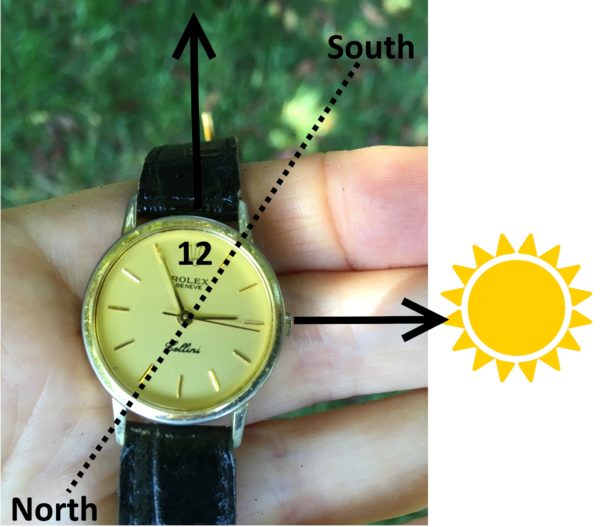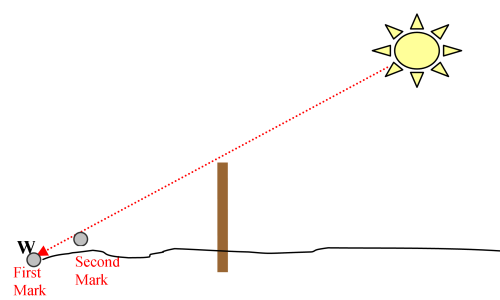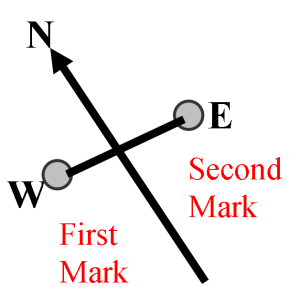Many hikers rely on GPS equipment for navigation in the wilderness rather than a compass and physical map. If something goes wrong with your device, it is prudent to know how to apply the necessary navigational skills. Using the sun is the most fundamental lesson in navigation. Roughly speaking, the sun rises in the east, sets in the west, and reaches its highest point in the sky at noon.
Using the Sun for Navigation
The sun always rises in the east and sets in the west. The earth spins towards the east, which means all the planets, the sun, moon, and stars all rise in the east and move westward across the sky. If you are lost and the time is between sunrise (say 6 am) and sunset (say 6 pm), the position of the sun is at “high noon” at half-day (noon).
- In the northern hemisphere: Around noon, the sun will point due south at its highest point in the sky. Shadows will move clockwise as the sun begins to descend on the horizon.
- In the southern hemisphere: The noonday sun will point due north when it reaches its highest point in the sky. Shadows will move counterclockwise.
Now watch the sun for a few minutes (say 15 mins) to see what direction it is moving. That direction is west. This gives you an approximate orientation based on the fact that the sun moves across the sky from East to West – everywhere in the world.
Depending on the season, the sun may not rise or set precisely due east or west, but knowing how to direct yourself accurately using the sun is far better than walking in circles.
Find North with an Analog Wrist Watch
If you have an analog wrist watch that is set to local time, then you can use it to create a line running from north to south. Here’s how:

Finding north-south in the northern hemisphere
If in the Northern Hemisphere: Hold the watch flat and point the hour hand at the sun. The midpoint between the hour hand and the twelve o’clock mark on your watch will give you an imaginary north-south line. If you are unsure which end of the line is north, remember that the sun rises in the east, sets in the west, and is due south at noon for the northern hemisphere. South will be the direction closest to the sun, and north will be the direction furthest from the sun.
If in the Southern Hemisphere: Hold the watch flat and point the twelve o’clock mark at the sun. The midpoint between the twelve o’clock mark on the watch and the hour hand will be your north-south line. In the southern hemisphere, the sun is due north at noon. North will be the direction closest to the sun, and south will be furthest from the sun.
You can also use a digital clock or device, but you have to imagine the clock hands in your mind to mimic an analog clock.
Find North by the Shadow-Tip Method
This simple method is highly accurate for finding direction by the sun. It uses four steps:
Step 1. Find a straight stick about 3 feet long, and anchor it into the ground on a level spot where the stick can cast a distinctive shadow. Mark the tip of the shadow with a stone, or other means. This first shadow mark is west– everywhere on earth.
Step 2. Wait 10 minutes until the shadow tip moves a few more inches. Mark the shadow tip’s new position like you did in step 1.
Step 3. Draw a straight line through the two marks to obtain an approximate east-west line.
Step 4. Stand with the first mark (west) to your left and the second to your right. The other directions are easy: you are now facing north, east is to your right, and south is behind you. This fact is true everywhere on earth.
Of course, this method assumes you can see the sun. There are other methods for night and cloudy day travel.
Find North by the Shadow-Tip Method
This simple method is highly accurate for finding direction by the sun. It uses four steps:
Step 1. Find a straight stick about 3 feet long, and anchor it into the ground on a level spot where the stick can cast a distinctive shadow. Mark the tip of the shadow with a stone, or other means. This first shadow mark is west– everywhere on earth.
Step 2. Wait 10 minutes until the shadow tip moves a few more inches. Mark the shadow tip’s new position like you did in step 1.

Step 3. Draw a straight line through the two marks to obtain an approximate east-west line.

Step 4. Stand with the first mark (west) to your left and the second mark to your right. The other directions are easy: you are now facing north, east is to your right, and south is behind you. This fact is true everywhere on earth.

Of course, this method assumes you are able to see the sun. There are other methods for the night and cloudy day travel.
2 thoughts on “Directional Navigation Using the Sun”
been very useful
If it is afternoon and the sun is past its zenith, then the first mark will be east.